E-Commerce Website UML Diagrams
E-Commerce Website UML Diagrams – are formed to design the structure and behavior of the project. These UML Diagrams were used to visualize the possible users, processes, activities and sequence of events in E-Commerce Website. Its purpose is to analyze, understand and know the needs of the project before developing it.
Table of contents
- E-Commerce Website UML Diagrams
- E-Commerce Website UML Diagrams: Name and Tools Used
- How to build E-commerce Website UML Diagrams?
- E-Commerce Website Project UML Diagrams:
- Class Diagram
- Use Case Diagram
- Sequence Diagram
- Activity Diagram
- Bonus Diagrams for E-Commerce Website
- Bonus Tips
- Conclusion:
- Related Articles:
- Recommended Articles from the Author:
- Inquiries:
E-Commerce Website UML Diagrams: Name and Tools Used
The table shows the overview of E-Commerce Website UML Diagrams. It tells the content of the article and tools used to create UML Diagrams.
| Name: | E-Commerce Website |
| Abstract: | The UML Diagrams are part of project documentation that represents the overall E-Commerce Website function. Each of these diagrams shows different visualization of E-Commerce Website structures and behavior. |
| UML Diagrams: | Class Diagram, Use Case Diagram, Sequence Diagram, and Activity Diagram. |
| Other Diagrams: | ER Diagram and DFD (Data Flow Diagram) |
| Tools used: | Lucidchart.com was used to create the diagrams but you may use other diagram tool. |
UML diagrams are based on the UML (Unified Modeling Language) used to describe the E-Commerce Website. It includes the major actors, roles, actions, artifacts, or classes, in order to better understand the information.
Software engineers uses UML modeling language to create diagrams. That is to provide ready-to-use, expressive modeling examples to users (programmers). The UML Diagrams are categorized into two types: the structural diagrams and the behavioral diagrams.
The Structural UML Diagrams represents the rightful structure and features of the E-Commerce Website. On the other hand, the Behavioral UML Diagrams illustrates the System’s behavior towards the users and data handling.
The UML Diagrams are part of project documentation that represents the overall E-Commerce Website. Each of these diagrams shows different visualization of E-Commerce Website structures and behavior. That is to know how the system handles data and interact with the targeted users.
The answer is “yes.” It’s because the UML diagrams are the blueprints of the system’s structure and behavior. Structural diagrams help in building the structure of an E-Commerce Website. The behavioral diagrams, on the other hand, help in determining the system’s behavior towards the user and data processing. All of the UML diagrams work in sync and relatively to achieve a well-engineered project.
How to build E-commerce Website UML Diagrams?
Time needed: 5 minutes
The UML Diagram development steps and guidelines are provided here. You don’t have to burden yourselves because each of these steps were also applied in the UML diagrams developed.
- Step 1: Gather Information
The first thing that you must do before building UML Diagrams for the website is to collect as much e-commerce data as you can. You’ll need to know how they manage products’ information and processing customer transactions.
You must complete all the necessary information in order to provide a quality software for them. Then you’ll apply the data gathered in designing the UML diagrams. - Step 2: Evaluate
After gathering much information, you will have to evaluate them. You will only include the important processes done in e-commerce website. The targeted users can help you in evaluating the needed processes. Then you will convert them into modules or features.
- Step 3: Start creating your Blueprint.
The blueprints stands for the diagrams that you’ll create. The information gathered and evaluated will be the important basis in creating it.
You will start segregating all the data according to the entities that needed to be emphasized. Example of which are:
• Class Diagram – focuses on data structures.
• Use Case Diagram – focuses on processes.
• Sequence Diagram – focuses on sequences of events.
• Activity Diagram – focuses on users’ activities or interactions with the system.
E-Commerce Website Project UML Diagrams:
The purpose of building the website is to provide the seller and buyers the easier and efficient way of doing purchase and endorsing products. And in order to do that, you have to complete the needed diagrams to perfectly furnish your project. Build your project completely using UML Diagrams to help you and keep you from errors.
Here are the UML Diagrams that composes an E-Commerce Website. Each of the UML Diagrams has a major role in achieving a well-developed E-Commerce Website. They were provided with the explanation on how does each of the diagram were created.
Class Diagram
The Class diagram for E-Commerce Website shows the structures data that will be handled in the website. These data or information will be represented by classes. Each of the classes will have their attributes in accord to the methods they will use.
The UML Class diagram was illustrated by a box with 3 partitions. The upper part was the name of the class, the middles are the attributes and the bottom is for the methods. The arrows on them represents their relationships in each other.
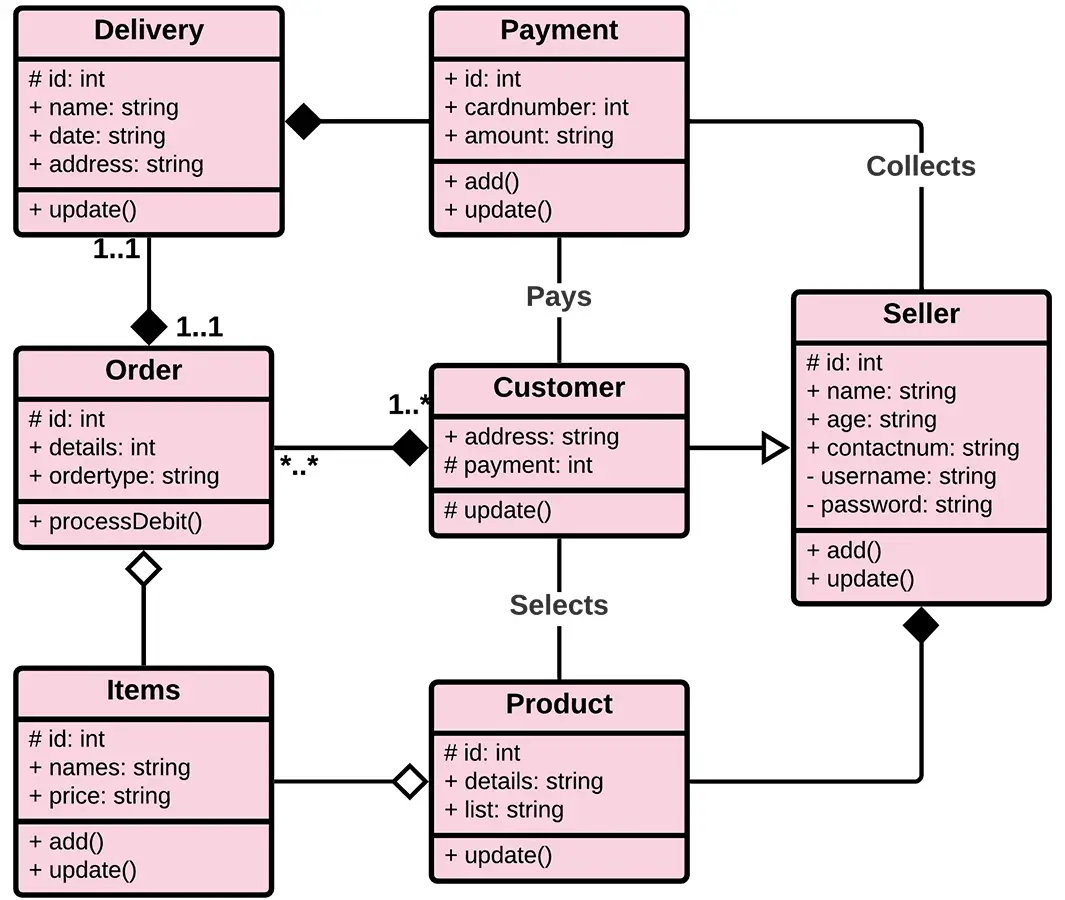
So the classes that are included in an E-Commerce Website would be the customers, products, sellers, stores, orders, deliveries and transaction.
Use Case Diagram
The use cases represents the main processes in E-commerce Website. Then they will be broken down into more specific use cases depending on the included sub-processes. Each of these use cases explains how the system handles the actions or scenarios requested by the user.
This diagram shows the general processes or function that the system could do. These processes are based on the activities done in the website.

E-Commerce Website General Use Case
This diagram shows the specified sub-processes which were based on the main process. These sub-processes describes the main process and shows you the series of events while doing online buying.
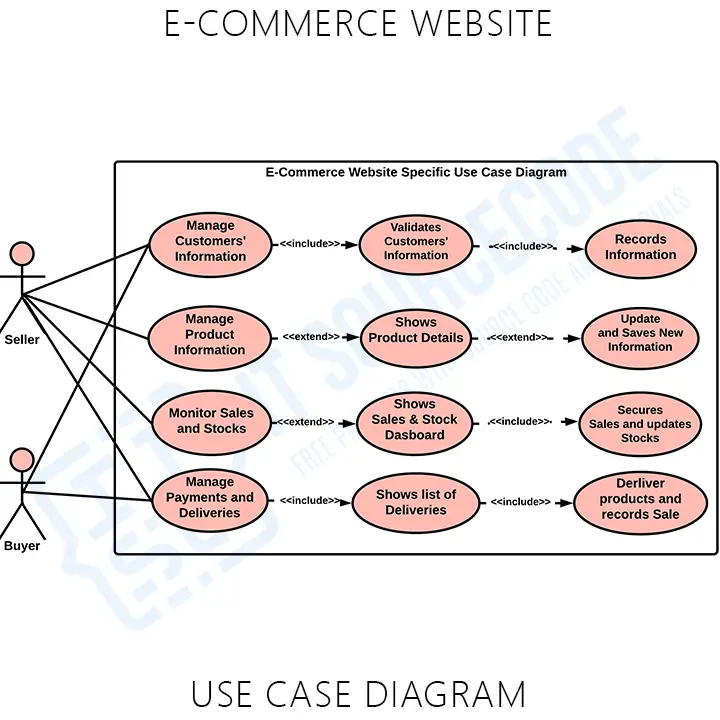
The UML Use Case Diagram is a design used as one of the Methodology on E-Commerce Website development. It represents the main functions or processes of the system as well as the specific processes included. They were also labelled properly to guide programmers and users about the structure of E-Commerce Website.
Sequence Diagram
The designed sequence diagram shows the series of events that occurs in E-Commerce Website. The actors are represented by a stick man and the transactions or classes are represented by objects. This gives you clear explanation E-Commerce Website behavior in terms of processing the flow of instructions.
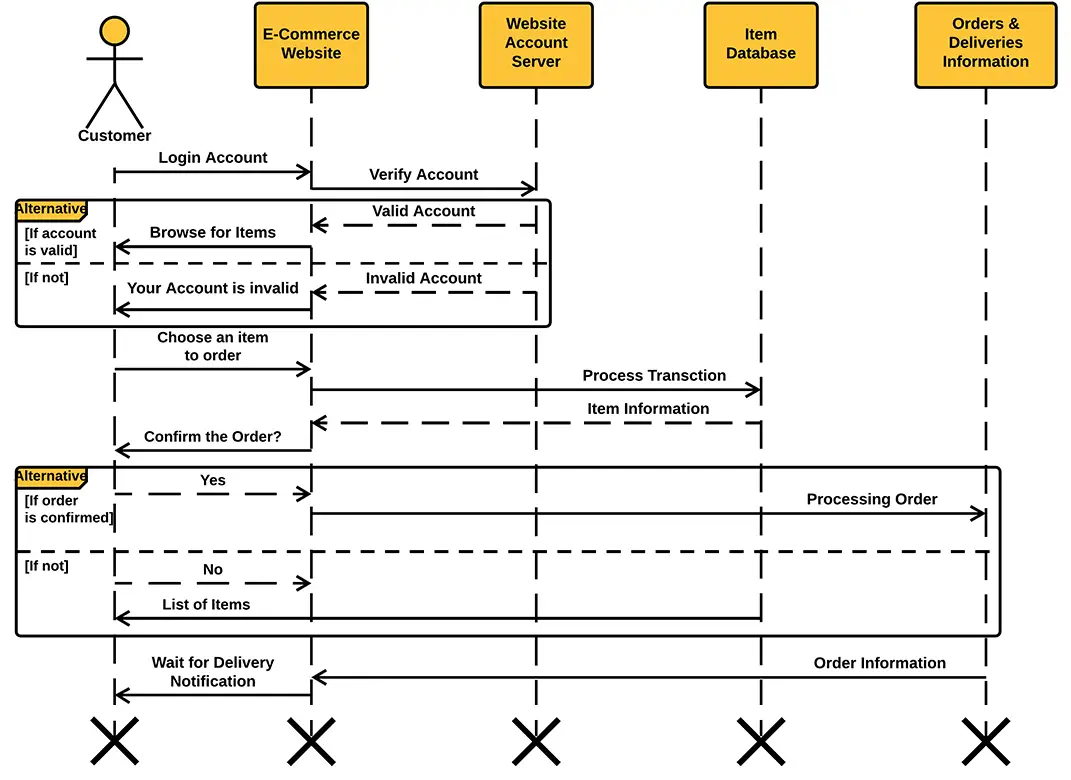
This designed sequence diagram is able to show programmers and readers about the sequence of messages between the actor and the objects.
Activity Diagram
The UML Activity Diagram is used to show the interaction between the user and E-Commerce Website. You’ll see the flaws of the system and avoid it using Activity Diagram on the project development.
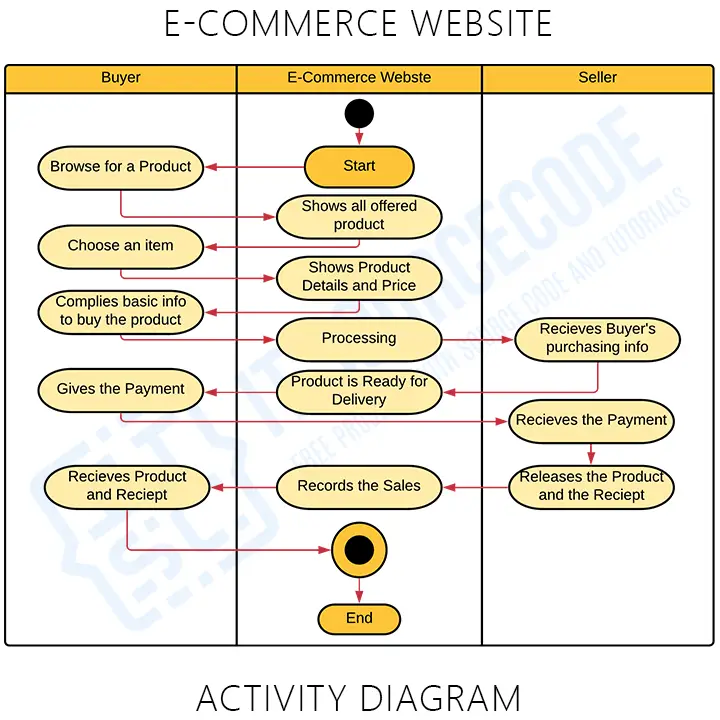
Now to create this diagram, you have to include the processes and users involve, then finalize the behavior of the proposed system.
Bonus Diagrams for E-Commerce Website
- E-commerce Website ER Diagram
This diagram shows the design of the system’s database. This design could be applied at the back end of the system development. It also serves as the design for the data storage that the system needs. It secures all the essential data in the system and preserves them for important task or when needed.
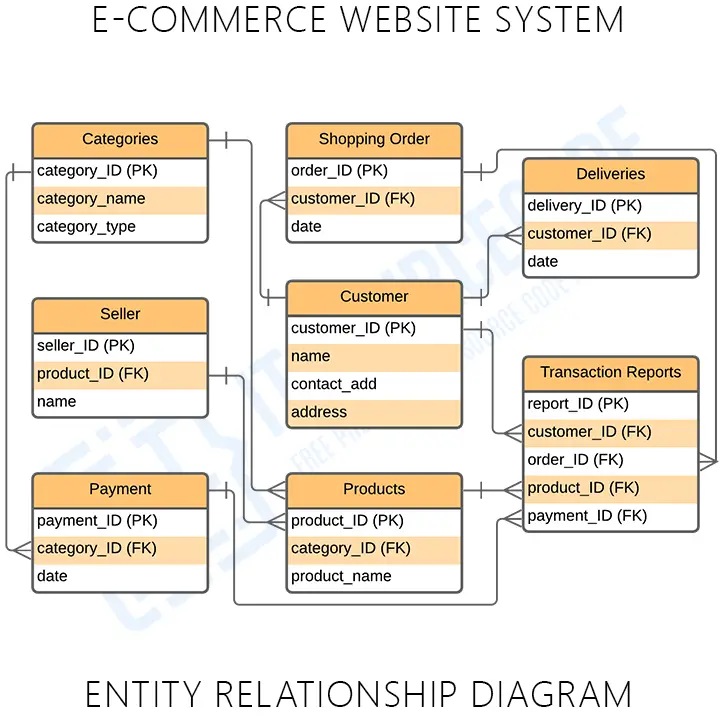
- E-commerce Website DFD
As addition to the diagrams that will be a big help in doing your Project is the Data Flow Diagram. It does not belong to the UML diagrams but it also helps in knowing more about the E-Commerce Website. So the DFD serves as an illustration of the systems data handling. It has levels 0, 1 and 2 and their diagrams are presented here:
E-Commerce Website’ context diagram presents the main idea to be the basis for the proceeding levels. The basic idea is represented by a single process consisting the main process, users and data.
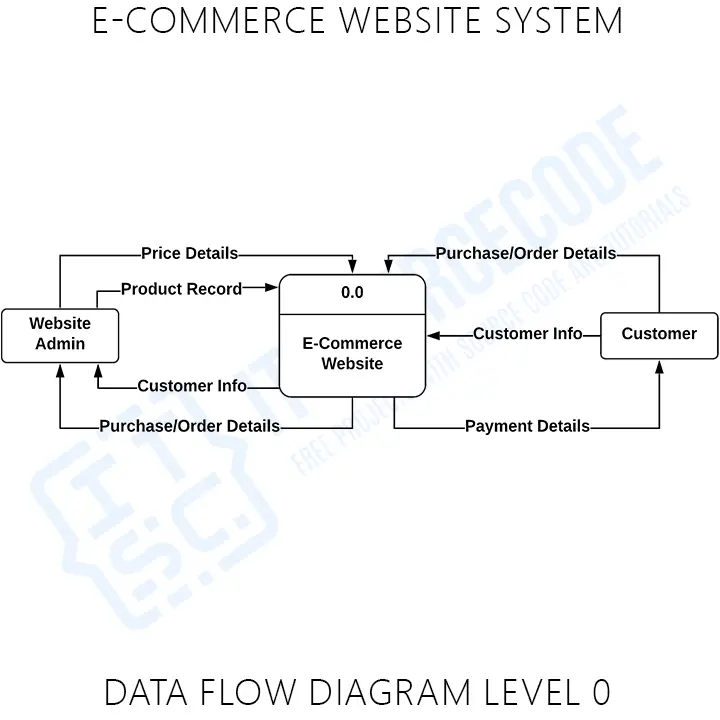
E-Commerce Website DFD Level 1 is the broadened context terms that consist of several processes derived from the main process.
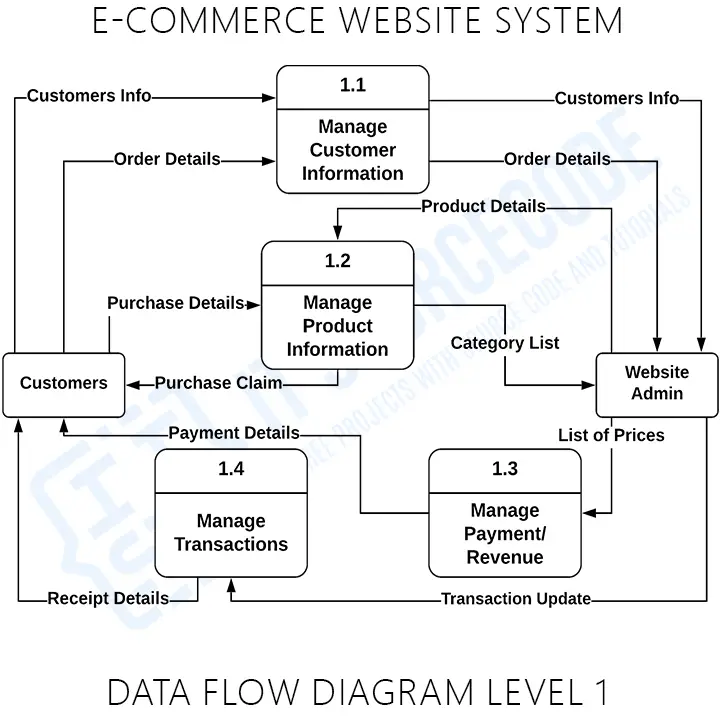
This level have the complete and detailed illustration of the project.
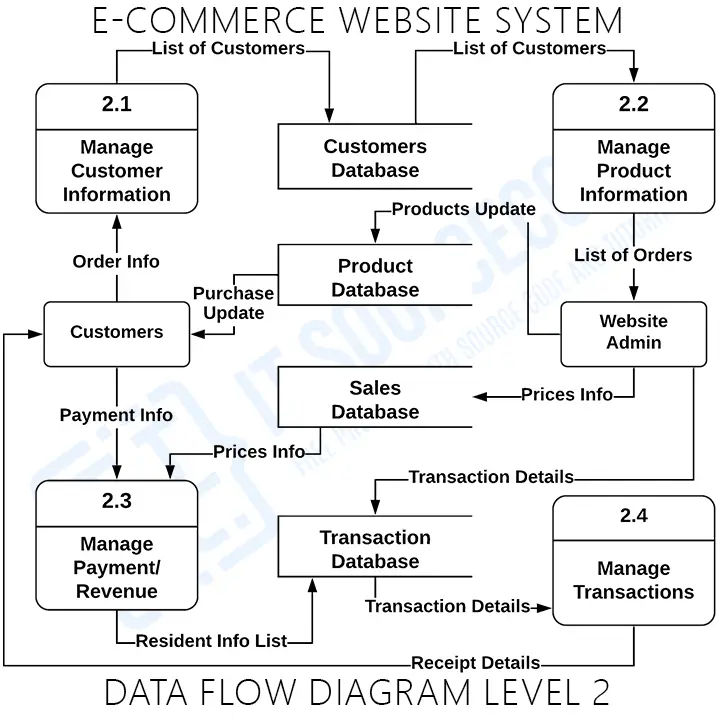
Bonus Tips
To design your UML diagram, you may use platforms and editing tools online. These tools are helpful since they already have the needed symbols to illustrate your diagrams. You just have to plot the included symbols, arrows and labels. The platforms or online tools that you may use are:
• Lucidchart
• Creately
• Smartdraw
• Edrawmax
• Canva
Conclusion:
As a whole, the UML Diagrams works together to achieve the most desired functions of the E-Commerce Website Project. All of these were designed to guide programmers and beginners about the behavior and structure of E-Commerce Website.
By completing all the given Diagrams, the E-Commerce Website development would be much easier and attainable. So those UML diagrams were given to teach you and guide you through your project development journey. You can use all of the given UML diagrams as your reference, or have them for your project development. The ideas presented in UML Diagrams were all based on E-Commerce Website requirements.
Related Articles:
- Point of Sale (POS) System UML Diagrams
- Bank Management System UML Diagrams
- Restaurant Management System UML Diagrams
- School Management System Project UML Diagrams
- College Management System Project UML Diagrams
- Blood Bank Management System UML Diagrams
Recommended Articles from the Author:
- E-Commerce Website using Django with Source Code
- [Complete] Laravel Ecommerce Project with Source Code
- Ecommerce in Javascript Framework with Source Code
Inquiries:
Now let me ask you something. What have you learned through the discussion? May this article help you with your projects in the future!
If you have inquiries or suggestions about E-Commerce Website Complete UML Diagrams just leave us your comments below.
Keep us updated and Good day!

